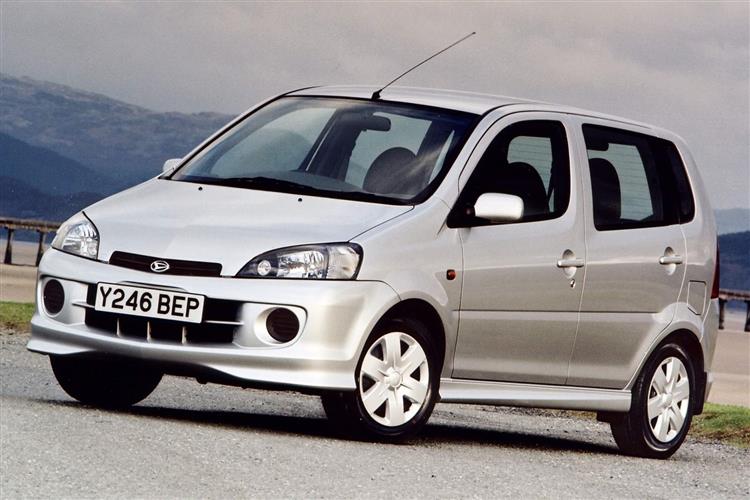YOU'RE ONLY YOUNG TWICE (some text hidden) --NONE--
BY ANDY ENRIGHT
Introductionword count: 70
Daihatsu's 'Young Recreational Vehicle' may not have had the nation scrambling for their chequebooks the first time around, but that doesn't mean it isn't a sound used purchase. With a weak reputation to fall back on, demand isn't huge, yet you're buying into a manufacturer with a superb reputation for reliability and innovation. Think of it as a cut-price Toyota Yaris and you won't be too far off the mark.
Modelsword count: 13
Models Covered: 5dr hatchback, 1.3 petrol [Base, Premium, Radical, Radical2, F-Speed, 4Trak, Turbo130]
Historyword count: 195
The YRV was introduced to the British public at the 2000 Birmingham Motor Show and was instantly viewed as just another in a long line of tiny Daihatsu oddities. The Cuore and Sirion models hadn't made much impact on domestic sales figures and although the YRV seemed an entire generation forward in terms of styling and build, few reckoned it would capture the public's imagination. And so it has proved. Two models were initially available, a standard trim base model and an upspec Premium trim level. These were followed in summer 2001 by the F-Speed which boasted a trick semi-automatic version and the 4Trak which, as its name suggests, was fitted with all-wheel drive. Perhaps realising that the aggressively priced Citroen Saxo was capturing the spoils in this market sector, Daihatsu released the Radical and Radical2 versions of the YRV, value models that lowered the entry price to YRV ownership to an accessible £7,995. All models were powered by the same 86bhp 1.3-litre engine until the YRV Turbo arrived with a 130bhp turbocharged version of that powerplant. The last YRVs were sold in 2005 once the model range had been replaced by a new Sirion.
What You Getword count: 542
Viewed from the front, the YRV could be nothing but Japanese. The slightly self-conscious detailing and twin-tracheotomy intakes either side of the numberplate are certainly more Tokyo than Turin, although the effect isn't altogether unattractive. From the side, the story gets more confusing. Borrowing elements of standard supermini design and adding the slightest dash of micro-MPV makes the YRV slightly uneasy on the eye. The overall effect is of a hall-of-mirrors VW Polo with some Toyota Yaris Verso genes thrown into the mix somewhere. The signature styling touch is the 'double-wedge' design applied to the side doors. Whereas most cars have a clearly defined 'belt line', in other words the line marked by the bottom of the side windows, the YRV junks this styling tradition. Instead it opts for two big windows which cant upwards at the bottoms. Distinctive, certainly, but does it work aesthetically? The jury's still out on that one. What is a deft touch is the addition of an optional 'panorama' fixed glass roof, which has the effect of making the windscreen look as if it arcs back into the roof. Seven YRV models are available, six of which are powered by that 86bhp 1.3-litre engine from part-owners Toyota, based on the unit fitted to the Yaris. Entry-level and Premium models based on a five-speed manual gearbox are most commonplace, but the more interesting variants are the four-wheel drive 4Trak and the YRV F-Speed. This range-topping version offers a Formula One-inspired steering wheel gear change, based on a conventional four-speed automatic gearbox. This system is operated with '+' and '-' buttons mounted on the arms of the steering wheels. To enable the system, a dashboard switch must be flicked, else the system reverts to operation via the standard floor-mounted gear lever. If the system is anything like other 'Tiptronic-style' gearboxes, it will allow for zippy downchanges and the added reassurance of keeping both hands on the wheel. Should you wish to cut costs, the Radical and Radical2 models offer pared down fun. The Turbo130 also offers a version of the sequential automatic gearbox, this time allied to a punchy 130bhp engine. From your position behind the wheel, the interior tries to appeal to Euro-tastes, but falls short in terms of plastics quality and a slight lack of a cohesive design theme. The dimple effect fascia and door trims are almost up to VW standards, but the aluminium-effect display panel is not carried off with any great conviction. Despite this, the YRV impresses with its tally of standard equipment. Some of the clever packaging ideas that were trialed on Daihatsu's mini-MPVs have found their way into the YRV. High-mounted rear seas that offer 150mm of sliding adjustment are fitted, and these seats can also be folded into an entirely flat position by virtue of boasting removable cushions. Models from standard trim upwards boast body coloured bumpers, mirrors and door handles, as well as central locking, electric door mirrors, electric windows all round and a driving seat height adjuster. The Premium manual and F-Speed models also add air conditioning, remote keyless entry, electronic brakeforce distribution (EBD) and alloy wheels as standard as well as the optional panorama glass roof. The 4Trak features an uprated stereo system and bigger wheels and tyres.
To see the full road test text contact us on 0330 0020 227
Pictures (high res disabled)

Scoring (subset of scores)
Category: Small Runabouts
| Performance | |
| Handling | |
| Comfort | |
| Space | |
| Styling, Build, Value, Equipment, Depreciation, Handling, Insurance and Total scores are available with our full data feed. | |



